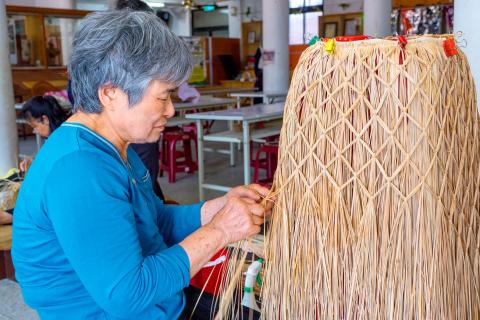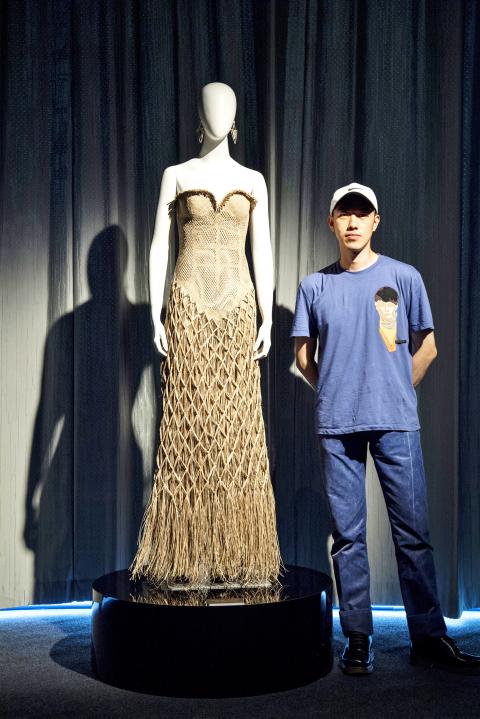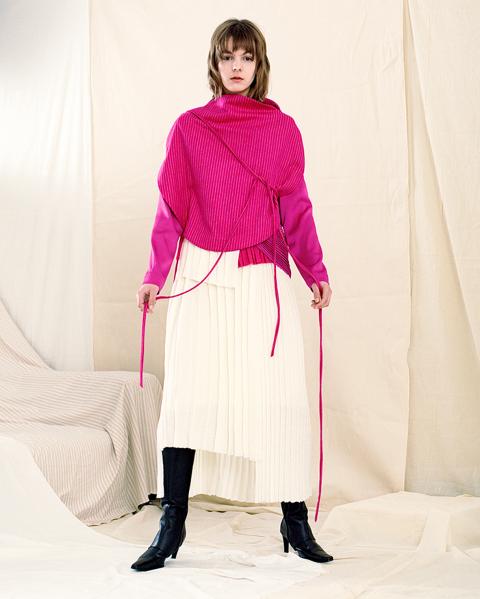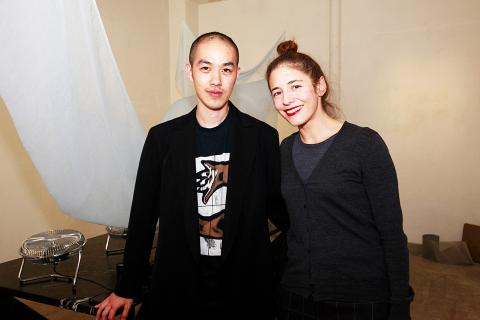For international fashion designer Chen Shao-yen (陳劭彥), the decision to relocate from London to Luodong (羅東) a few months ago felt like a natural progression in his career. The Yilan native and Central Saint Martins graduate may have dressed Lady Gaga and Bjork, but a change from the fast pace of London’s fashion world was necessary for the evolution of his sleek yet avant-garde womenswear label, Shao Yen.
UNDER CONSTRUCTION
Chen’s studio was still being renovated when I visited last week. Antique mannequins and trunks shipped from London are scattered across the ground floor, which he plans to convert into a showroom by August. The balcony doors, made out of cypress from nearby Taiping Mountain (太平山), remain intact, though Chen and his team hired workers to peel off the seven layers of paint from the walls of the narrow, four-story shop house. Exposed are subtle cracks in the original gray paint from the 1960s.

Photo courtesy of Shao Yen Design Concepts
The smallest township in Yilan County (宜蘭), Luodong was once a thriving hub for garment production in the 1960s and 70s. Today, old shop houses once belonging to tailors, seamstresses and pattern cutters are left largely abandoned save for a few remaining small businesses.
A whiff of cedar from the nearby Luodong Forestry Culture Garden (羅東林業文化園區) is discernible from outside the studio. The park was formerly the site of a Japanese-run logging business during the colonial era, the wood from cypress trees shipped to Japan.
“We wanted to peel off the layers of paint and let people see the history of the place,” says Chen, who grew up in Yilan City near Luodong.

Photo courtesy of Shao Yen Design Concepts
“Also, we don’t have the money to renovate it,” he adds, half-jokingly.
Chen and his label’s Executive Director Lawrence Chuang (莊國琳) had just returned from a meeting with a pattern cutter when I arrive. They tell me that while business was once booming, the pattern cutter plans to retire and his children are not keen to learn the trade.
It’s part of a trend that has been going on for the last decade, as more and more young people leave for Taipei to find work.

Photo courtesy of Shao Yen Design Concepts
The soft-spoken Chen, dressed in a t-shirt, sandals and pants rolled up to the ankles, is determined to gradually turn this around by working with local tradespeople to create haute couture that interweaves elements of traditional handiwork. So far, it’s proved to be a daunting task as many of the craftsmen they’ve approached aren’t used to such collaborations.
“We recognize that it’s a process that will take time and it’s important that we get to know the locals and understand their work ethic,” Chen says.
FASHION AS A CRAFT

Photo courtesy of Shao Yen Design Concepts
Chen is known for his collaborations with artists, dancers and performers at Fashion Week shows in Paris and London. He collaborated with Japanese sound artist Tomoko Sauvage at Paris Fashion Week last year to showcase his Spring/Summer 2016 collection, “Joint,” and has worked with Taiwanese sculptor Chou Shih-hsiung (周世雄) and architect Chuang Yao-jen (莊曜任) for past runway shows and projects.
The recent idea to get local craftsmen and women involved in his projects stemmed partly from a collaboration with straw weavers from the Miaoli-based (苗栗) Taiwan Yuanli Handiwork Association (台灣藺草學會) last year. Two of the older weavers from the association helped hand-weave the bottom half of a straw dress designed by Chen and worn by actress Shu Qi (舒淇).
A form-fitting and elegant mermaid-like design consisting of delicate knots and painstaking detail, the dress is not too big of a digression from Chen’s signature monochrome runway couture accentuating the awkwardness of the joints and contours of the female form.

Photo: Dana Ter, Taipei Times
It is also an example of how traditional craft and high fashion need not be mutually exclusive. For Chen, there’s a story to be told in his dresses, introducing the world to Taiwan’s history, as well as reminding Taiwanese of their heritage.
“Infusing traditional elements into modern designs can help draw interest to these local histories,” Chen says.
But there’s more to it than that. What’s motivating him is a belief that fashion (in particular, fashion that is not mass produced) should be appreciated for what it is — an art.
“Before fashion, was, well, fashion, it was a craft, it was something people took pride in making,” Chen says.
He says that high-end luxury brands such as Prada and Louis Vuitton started by producing handmade suitcases.
Chen, who also hand stitches parts of his designs, says that the process of learning even a simple trade, for example crochet or weaving, is something that few young, aspiring designers are willing to invest in.
They have dreams of becoming fashion designers, not tailors, he says. While one connotes a glamorous life in the spotlight, the other is a labor of love.
“Young people generally want to succeed easily,” the 34-year-old quips.
SLOW FASHION
Incorporating elements of traditional handiwork is based on Chen’s belief that while fashion trends eventually die out, art will live on. Naturally, the long-term objective is to become a classic, timeless label — a huge feat for a brand that is less than six years old.
It is a belief, he says, that is rooted in the disillusionment with “fast fashion,” a term used to describe how quickly fashion trends move from the catwalk to stores via large retailers who find ways to inexpensively manufacture clothing for mainstream consumers desiring these so-called “in style” items at reasonable prices.
Besides the lack of originality in design concept, both Chen and Lawrence Chuang cite numerous cons with fast fashion. For example, killing animals for fur, dying fabrics (which could end up harming the environment) and the oppressive working conditions for garment factory workers worldwide — something which the Bangladesh factory collapse in 2013 aptly highlighted.
It’s Lawrence Chuang who puts in simply: “fast fashion is quite cheap.”
Chen and his team are responding to this by producing a sort of “slow fashion.” The surrounding backdrop of Luodong — quiet alleys, old tailor stores operating in their neighborhood and the picturesque lake in the Luodong Forestry Culture Garden — has helped them de-stress and work at a slower pace while still staying focused on projects.
Currently, Chen is working on several designs for singers Tanya Chua (蔡健雅) and Hebe Tien (田馥甄), as well as a collaborative project with calligrapher Tong Yang-tze (董陽孜).
Chen says he will be taking a break from the upcoming London Fashion Week in September, and though he will be based in Luodong for the foreseeable future, he plans to travel to Europe for each season of Fashion Week starting next year.
In the meantime, he’s content with the way things are.
“We’re just creating our own path,” Chen says.

On the evening of June 1, Control Yuan Secretary-General Lee Chun-yi (李俊俋) apologized and resigned in disgrace. His crime was instructing his driver to use a Control Yuan vehicle to transport his dog to a pet grooming salon. The Control Yuan is the government branch that investigates, audits and impeaches government officials for, among other things, misuse of government funds, so his misuse of a government vehicle was highly inappropriate. If this story were told to anyone living in the golden era of swaggering gangsters, flashy nouveau riche businessmen, and corrupt “black gold” politics of the 1980s and 1990s, they would have laughed.

This is a deeply unsettling period in Taiwan. Uncertainties are everywhere while everyone waits for a small army of other shoes to drop on nearly every front. During challenging times, interesting political changes can happen, yet all three major political parties are beset with scandals, strife and self-inflicted wounds. As the ruling party, the Democratic Progressive Party (DPP) is held accountable for not only the challenges to the party, but also the nation. Taiwan is geopolitically and economically under threat. Domestically, the administration is under siege by the opposition-controlled legislature and growing discontent with what opponents characterize as arrogant, autocratic

When Lisa, 20, laces into her ultra-high heels for her shift at a strip club in Ukraine’s Kharkiv, she knows that aside from dancing, she will have to comfort traumatized soldiers. Since Russia’s 2022 invasion, exhausted troops are the main clientele of the Flash Dancers club in the center of the northeastern city, just 20 kilometers from Russian forces. For some customers, it provides an “escape” from the war, said Valerya Zavatska — a 25-year-old law graduate who runs the club with her mother, an ex-dancer. But many are not there just for the show. They “want to talk about what hurts,” she

It was just before 6am on a sunny November morning and I could hardly contain my excitement as I arrived at the wharf where I would catch the boat to one of Penghu’s most difficult-to-access islands, a trip that had been on my list for nearly a decade. Little did I know, my dream would soon be crushed. Unsure about which boat was heading to Huayu (花嶼), I found someone who appeared to be a local and asked if this was the right place to wait. “Oh, the boat to Huayu’s been canceled today,” she told me. I couldn’t believe my ears. Surely,